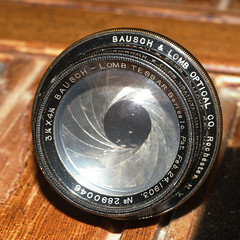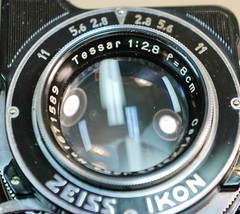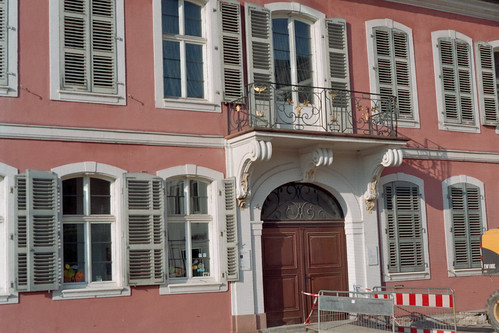Tessar

|
| original Tessar from Zeiss collection image by Uwe Kulick (Image rights) |
The Tessar is a camera lens designed by Paul Rudolph, working for the Carl Zeiss Jena company, in 1902. It is normally used as a standard lens, and versions of it have been fitted to many millions of cameras.
The design consists of four elements in three groups; the front element is positive, bi-convex (with the rear almost flat), the central a negative bi-concave and, following an aperture, at the rear is a cemented doublet of plano-concave and a bi-convex elements. Though often referred to as a "modified Cooke triplet", the Tessar is actually a development of Rudolph's 1899 Unar (4 element in 4 groups) lens, itself a development of Rudolph's 1890 Zeiss Anastigmat (4 elements in 2 groups) lens.

|
| Cross-section of a 50mm f2.8 Tessar, with front element on the left. (for 35mm, M42 fitting) by AWCam (Image rights) |

|
| Cut-away diagram of a Tessar scanned by Uwe Kulick (Image rights) |
The original design had a maximum aperture of f/6.3, but the developments in design allowed f/2.8 by 1930.
In addition to production by Carl Zeiss, the Tessar name and design (under license) was used in the production of numerous lenses by Bausch & Lomb (Rochester), Ross (London) and Krauss (Paris).
The Tessar design has been widely copied by nearly all major optics companies. By 2002, Carl Zeiss, Inc. had produced over five millions Tessar lenses, and they estimated the total number of Tessar formula lenses at more than 150 million.[1]
A very partial list includes:
- Agfa Solinar
- Asahi/Pentax Macro-Takumar 50mm f/4
- Bausch & Lomb Tessar (under license)
- Canon 50mm FL f/3.5, 38mm FLP, 50mm f/2.8 and f/3.5(RF), 35mm f/3.5(RF)
- Dallmeyer Dalmac, Perfac, Serrac
- Ernemann Ernon

|
| Tessar Series 1c Pat Feb 24, 1903 made by Bausch & Lomb image by Nesster (Image rights) |
- FED/KMZ Industar
- Ilex Paragon
- Kodak Ektar
- Konica Macro-Hexanon AR 55 mm f/3.5
- Krauss-Zeiss Tessar (under license)
- Leitz Elmar
- Mamiya Press lenses - 100mm f/3.5, 127mm f/4.7, 150mm f/5.6
- Meyer Primotar
- Minolta Rokkor TLR
- Minox Minoxar
- Nikon 45mm GN Nikkor, El-Nikkor 50mm f/4
- Olympus in many of their compact cameras including the Trip 35 (40mm f/2.8) and mju series.
- Plaubel Anticomar
- Rodenstock Ysar, Rogonar
- Ross Xtralux

|
| Tessar on Ikonta image by Mario Groleau (Image rights) |
- Ross Tessar (under license)
- Schneider Xenar, Comparon
- Taylor & Hobson Apotal, Ental
- Voigtlander Heliostigmat, Skopar
- Wollensak Raptar
- Yashica Yashinon TLR, Yashica T AF
- Zeiss Tessar
Sources

|
| imaging sample, Tessar on Belca Beltica image by Uwe Kulick (Image rights) |
Books
- Rudolf Kingslake, A History of the Photographic Lens, Academic Press, 1989
Links
- How to clean or repair a 50mm f2.8 Tessar, by Michel Pollet
- Innovation 11, 100th Anniversary of the Tessar
References
- ↑ Innovation – The Magazine from Carl Zeiss", Issue 11, Carl Zeiss, Inc.